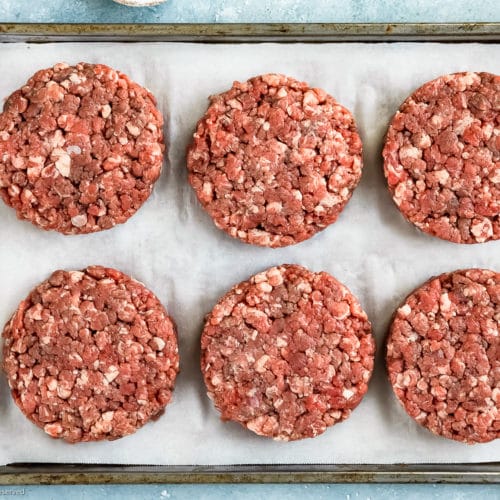
When it comes to making an amazing burger, ground beef is the popular choice of meat. But there are others. You can even mix and match your meats! But first, to make the best burger, there are several factors to consider.

Percentage of Fat
This is one of the big ones. Fat provides moisture and flavor to the meat, and when you’re cooking over a hot grill, fat helps prevent the burger from drying out. The optimal fat content for burgers is 15 to 20 percent.
This means we can rule out quite a few different cuts of meat whose fat content is too low. Round and sirloin, for instance, are too lean to make good burgers.
Beef chuck happens to fall right in the sweet spot of 15 to 20 percent fat (sometimes you’ll see it marketed the other way round, as in 80 to 85 percent lean, or simply 80/20, 85/15, and so on). Its deep beefy flavor with ample, but not excessive, fat makes ground chuck the best meat for burgers.
Coarse Grind
Coarse grind refers to the setting on the grinder attachment that is used to grind the meat. A coarse grind means the meat is ground using plates with larger holes in it, producing a coarser texture.
You’ll almost always get a coarse grind with store-bought ground beef and pork. It’s with ground turkey and chicken that you might run into a finer grind, because ground poultry tends to include more cartilage, and the finer grind helps make those bits more palatable. Still, a finer grind produces a mushy texture. The meat is not so much ground as it is extruded into almost a paste. Needless to say, this is not a desirable texture for a burger.
Forming the Patty
Along with shaping the patty, here is where you’ll introduce any additional ingredients, such as the requisite salt and pepper; along with chopped onions, garlic, fresh or dried herbs and so on.
While it can be tempting to load the meat with seasonings and flavoring ingredients, don’t go overboard. Too many additions, particularly if the pieces are on the large side, will weaken the patty, causing it to fall apart on the grill when you try to turn it.
And when you form the meat into a patty, do it gently. Packing the patty tightly will produce a hard burger.
Mixing Meats
Just because chuck is the best meat doesn’t mean it’s the only meat. You can use ground round to make a burger, but to boost the fat content try combining it with ground pork, which has a fat content of 20 to 25 percent. Not only will the additional fat balance out the leanness of the round, but it will also contribute a lovely porky flavor, making it almost like a bacon burger.
You can use this trick with ground turkey or chicken as well. Both of which are too lean to make good burgers on their own.
Another trick is if you grind your own meat. Buy some pork fatback from your butcher and add it to the grinder along with your leaner beef or poultry. Again, whatever you need to do to achieve that 15 to 20 percent fat content. For a spicy kick, consider one part ground sausage for three parts ground beef.
Grilling Your Patty
Unlike a steak, which is best cooked medium-rare (or at most medium), a burger needs to be cooked somewhere in the vicinity of medium-well to well (which corresponds to an interior temperature of 150 to 160 F). This is all well and good, but the trick is cooking it to the required interior temperature without cooking the exterior to a blackened shell.
To pull this off, make sure that you cook them over a medium-temperature grill, rather than a high one. Indirect heat can also help, especially when it comes to preventing flare-ups caused by dripping fat.
All the Fixings
To complete your burger, think of “the fixings” in terms of the following three elements: cheese, condiments, and toppings.
Cheese should be melted directly on the patty during the last minute of cooking. American, cheddar, blue, goat, Havarti, pepper jack, and brie are all excellent choices. Choose one!
Condiments can include anything from ketchup, mustard, and mayo to BBQ sauce, Russian dressing, steak sauce, and truffle aioli, to name just a few. But more than three is usually overkill. To keep the bun from falling apart, apply condiments to the top half of the bun only (or the top of the toppings stack).
When it comes to toppings, the rule of three also applies, but consider some of the following, listed in order of where you would stack them, from top to bottom:
- Sauerkraut: drain well
- Pickles: sliced thinly
- Jalapeños: go easy
- Mushrooms: grilled portobellos
- Caramelized onions: cooked slowly
- Bacon:crispy but not crumbly
- Fried egg: crisp edges
- Chili: directly atop the cheese





